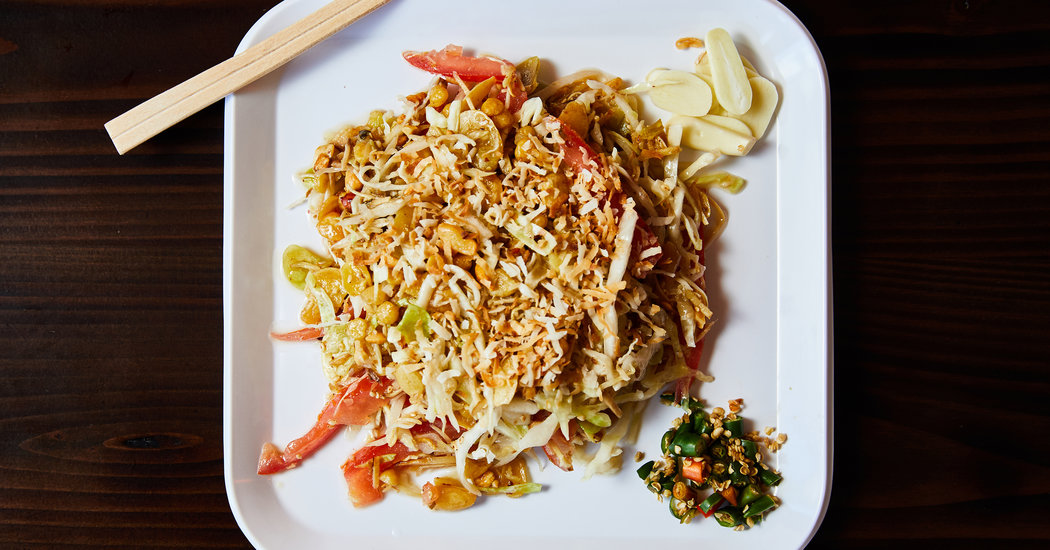
It would be so easy to pass this storefront by, here on a slant off the 67th Avenue stop in Forest Hills, Queens. The name is reassuringly vague — there might well be an Asian Bowl in every city across the United States — giving chef and diner alike license to roam.
But on the table is a dish that tells a more singular story: gin thoke, nearly see-through strands of ginger pickled in lime to numb their sting, snaking through a heap of cabbage, garlic fried hard and garlic unsubdued, tiny dried shrimp, sesame seeds, and split lentils and beans crisped but still meaty at the center.
There are peanuts in there, too, roasted and shattered. And tomato, thin arcs with just enough juice, sweet and bright.
It’s tricky to pin down the contributions of individual ingredients, and beside the point: The dish is a marriage of raw and cooked, fresh and aged, with a hundred minuscule but distinct shifts in crunch. Eat it, and it’s like day has begun, whatever the hour. It wakes you up.
This is Burmese food, still a rarity in New York. For a brief moment last year, the city could claim three Burmese spots; then Rangoon Spoon closed, leaving only Together, in Bensonhurst, Brooklyn, and the Burmese Bites food cart in Long Island City, Queens.
Like many small, immigrant-run restaurants, Asian Bowl has no public relations team. The owners, Kyaw Lin Htin and Aye Thida, did not make an announcement in February when they took over what had been a generalist Chinese takeout shop. Outside, the image on the sign — a blue-and-white porcelain bowl with chopsticks atilt — was left untouched.
Later that month, the Queens food blogger Joe DiStefano, who lives around the corner, stopped by and learned that the new owners were planning to offer sushi and Burmese food. “If you make mohinga” — a breakfast soup of fish and noodles — “I’ll come every day,” he told Mr. Kyaw Lin Htin. This may have tipped the balance: Although sushi is on the menu, it’s no longer served, and on my visits, everybody was ordering Burmese.
Ms. Aye Thida, the chef, grew up in her family’s restaurants in Yangon, the former capital of Myanmar. For mohinga, she poaches catfish, then lifts the flesh from the bones, which are returned to the pot to steep with lemongrass, garlic and ginger and leach into stock.
Some versions of the dish are light, some thick enough to drag the spoon. Here it’s in between, the broth given body by chickpeas boiled and ground into flour and rice powder brought to brown in a pan. On the side are fritters that look like chickpea brittle, to be crumbled into the soup, and lime, to squeeze for as much sunniness as you wish.
Mr. Kyaw Lin Htin came to New York first, in 2002, one of the lucky ones to get a green card through the diversity visa lottery for people in countries that have historically sent few immigrants to the United States. His wife joined him two years later and found work in the diamond district, while he learned to make sushi, a livelihood for many Burmese immigrants.
At Asian Bowl, she has a chance to share what she’s long cooked at home: cool salads that may be soured with pickled shrimp or bear the twangy zip of fermented tea leaves; noodles skinny, glassine or flat — sometimes all tangled together — contoured by yellow bean powder, perhaps, or pulverized dried shrimp; and curries that range from mild gravies to a fury of chiles over dark hunks of beef.
Pork intestine rests in whorls alongside liver and quail eggs in kyay oh, noodles that may be submerged in soup or, even better, served “dry” — that is, simply glossed in melted pork fat that’s been heavily infused with garlic, and accompanied by a cup of broth to settle the palate between bites.
Squash, potatoes and great leaves of watercress arrive in bubbled gold, battered and fried like tempura. They crackle, but are just an excuse; the dipping sauce, a heady swirl of tamarind, is all.
Although I’ve eaten Burmese food elsewhere, in New York and in Myanmar, I didn’t recognize half the dishes, which was thrilling. Mr. Kyaw Lin Htin showed me photos on his phone — a more explanatory menu is in the works — and gave me gentle warnings: Are you O.K. with pork intestine? Be careful, the fish has bones.
And, gentlest of all: Maybe you order too much.
Follow NYT Food on Twitter and NYT Cooking on Instagram, Facebook, YouTube and Pinterest. Get regular updates from NYT Cooking, with recipe suggestions, cooking tips and shopping advice.





